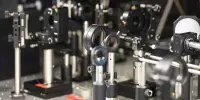Breast cancer identification at an early stage is crucial for enhancing survival rates and treatment results. Wearable ultrasound scanners may enable more frequent and convenient scans, making it easier to spot abnormalities in breast tissue at an earlier stage.
Researchers developed a wearable ultrasound gadget in the hopes of boosting the survival rate of breast cancer patients. When breast cancer is detected in its early stages, the survival rate is approximately 100 percent. However, for cancers discovered in later stages, the incidence lowers to roughly 25%.
MIT researchers have created a wearable ultrasound gadget in the aim of boosting the overall survival percentage for breast cancer patients. It could be especially beneficial for those at high risk of getting breast cancer between routine mammograms.
The gadget is a flexible patch that can be fastened to a bra and allows the wearer to move an ultrasound tracker along the patch and scan the breast tissue from various angles. In the latest study, the researchers demonstrated that they could get ultrasound images with resolution equivalent to that of ultrasound probes used in medical imaging centers.
This technology provides a fundamental capability in the detection and early diagnosis of breast cancer, which is key to a positive outcome. This work will significantly advance ultrasound research and medical device designs, leveraging advances in materials, low-power circuits, AI algorithms, and biomedical systems.
Anantha Chandrakasan
“We changed the form factor of the ultrasound technology so that it can be used in your home. It’s portable and easy to use, and provides real-time, user-friendly monitoring of breast tissue,” says Canan Dagdeviren, an associate professor in MIT’s Media Lab and the senior author of the study.
MIT graduate student Wenya Du, Research Scientist Lin Zhang, Emma Suh ’23, and Dabin Lin, a professor at Xi’an Technological University, are the lead authors of the paper, which appears today in Science Advances.
A wearable diagnostic
Dagdeviren was inspired for this project by her late aunt, Fatma Caliskanoglu, who was diagnosed with late-stage breast cancer at the age of 49 despite having routine cancer screenings and died six months later. Dagdeviren, then a postdoc at MIT, created a preliminary design of a diagnostic gadget that might be put into a bra and would enable for more frequent screening of women at high risk for breast cancer at her aunt’s bedside.
Breast tumors that form between routine mammograms, known as interval cancers, account for 20 to 30 percent of all breast cancer cases, and these tumors are more aggressive than those seen during routine screenings.

“My goal is to target the people who are most likely to develop interval cancer,” says Dagdeviren, whose research group specializes in developing wearable electronic devices that conform to the body. “With more frequent screening, our goal to increase the survival rate to up to 98 percent.”
To make her vision of a diagnostic bra a reality, Dagdeviren designed a miniaturized ultrasound scanner that could allow the user to perform imaging at any time. This scanner is based on the same kind of ultrasound technology used in medical imaging centers, but incorporates a novel piezoelectric material that allowed the researchers to miniaturize the ultrasound scanner.
To make the device wearable, the researchers designed a flexible, 3D-printed patch, which has honeycomb-like openings. Using magnets, this patch can be attached to a bra that has openings that allow the ultrasound scanner to contact the skin. The ultrasound scanner fits inside a small tracker that can be moved to six different positions, allowing the entire breast to be imaged. The scanner can also be rotated to take images from different angles, and does not require any special expertise to operate.
“This technology provides a fundamental capability in the detection and early diagnosis of breast cancer, which is key to a positive outcome,” says Anantha Chandrakasan, dean of MIT’s School of Engineering, the Vannevar Bush Professor of Electrical Engineering and Computer Science, and one of the authors of the study. “This work will significantly advance ultrasound research and medical device designs, leveraging advances in materials, low-power circuits, AI algorithms, and biomedical systems.”
Early detection
The researchers tested their gadget on one human subject, a 71-year-old lady with a history of breast cysts, in collaboration with the MIT Center for Clinical and Translational Research. The researchers used the novel technology to detect cysts as small as 0.3 millimeters in diameter – the size of early-stage malignancies. They also demonstrated that the device has a resolution comparable to standard ultrasonography and that tissue can be seen at depths of up to 8 cm.
“Access to quality and affordable health care is essential for early detection and diagnosis. As a nurse I have witnessed the negative outcomes of a delayed diagnosis. This technology holds the promise of breaking down the many barriers for early breast cancer detection by providing a more reliable, comfortable, and less intimidating diagnostic,” says Catherine Ricciardi, nurse director at MIT’s Center for Clinical and Translational Research and an author of the study.
The researchers must presently connect their scanner to the same type of ultrasound machine used in imaging centers in order to view the ultrasound images. They are currently working on a tiny version of the imaging system the size of a smartphone.
The researchers anticipate that the wearable ultrasonography patch might be used at home by those who are at high risk for breast cancer and would benefit from frequent screening. It may also aid in the diagnosis of cancer in persons who do not have frequent access to screening.
“Breast cancer is the most common cancer among women, and it is treatable when detected early,” says Tolga Ozmen, a breast cancer surgeon at Massachusetts General Hospital who is also an author of the study. “One of the main obstacles in imaging and early detection is the commute that the women have to make to an imaging center. This conformable ultrasound patch is a highly promising technology as it eliminates the need for women to travel to an imaging center.”
The researchers intend to create a system in which, after data is collected from a subject, artificial intelligence may be used to examine how photos evolve over time, perhaps providing more accurate diagnostics than depending on a radiologist’s judgment of images taken years apart. They also intend to investigate using ultrasonic technology to scan other regions of the body.















